Introduction
The pain during different surgical procedures makes a terror to the patient. The surgeon’s aim is to produce optimum painless surgery. Most of the minor oral surgical procedures are performed under local analgesia but there are so many disadvantages of using local analgesia. From time to time various attempts have been made to discover agents which eliminate pain during extraction. New local analgesic drugs have been discovered to achieve pain less extraction. In spite of the introduction of a number of local analgesics, none has been proved ideal. Even the commonly used drug Lignocaine hydrochloride is known to produce both local and systemic side effects. Acupuncture which an old traditional Chinese method of treatment, has been claimed a better method for painless tooth extraction and is now becoming popular in various countries of the world[1],[2],[3],[4]. Acupuncture is a technique, in which disease is treated by inserting needles at various points on the body- acupuncture points [5],[6]. In recent years interest in acupuncture for dentistry has increased. Global literature is devoid of any proper organized clinical trial for evaluation of role of acupuncture analgesia in various dental procedures.
Materials And Methods
The present study was conducted on one hundred patients of varying age and sex, requiring at least two tooth extractions, selected from our Department of Oral and Maxillofacial Surgery. Children and medically compromised patients were not included in the study due to the difficulty of explaining the acupuncture technique and complications during the intra -operative and post-operative procedure. In each patient two teeth was extracted one under xylocaine hydrochoride and other under acupuncture. Extractions were done at the interval of seven days. In xylocaine group, xylocaine hydrochoride (2%)with or without adrenaline(1:80,000) was used for anesthetising the teeth and surrounding structures. In acupuncture group, stainless steel needles with silver handles of two different sizes (1” and 1.5”) and of diameters (Gauge No.28 and 30) were used. Smaller needles were used for the local points on face while larger needles were used for the distal points. The electrical stimulation was done with a 6 volts ,low frequency(30Hertz) dens disperse current of bearable intensity, using electrical pulses for 90 to 120 sec. During electrical stimulation the patient was watched carefully and if there was any unbearable feeling the frequency was reduced. The following points were used for acupuncture analgesia.
A. Local points
For Upper jaw
(a) Central incisor and lateral incisor -Renzhong (Du26)
(b) Canine - Nose-Helino (L.I. 19)
(c) Canine and Premolars - Yingxiang (L.I.29)
(d) Premolars - Dicang (st.4)
(e) First Molar - Quanlio (S.I.18)
(f) Second and Third Molar - Zianglian (st.7)
For Lower Jaw
(a) Central incisor and lateral incisor - Chengying(Ren24)
(b) Premolars - Daying (st.5)
(c) Molars - Jiache (st.6)
B. Distal Point
For all points - Hegu (L.I.4)
Stimulation was performed either by acupressure or by needles manually or electrically. In all cases acupressure was applied with the index finger at the selected acupuncture points on the respective side of the face. Needle was stimulated by either manual or electrical stimulation. The electrical stimulation was done with 6 volts; low frequency (30Hertz) dens disperse current of bearable intensity, using electrical pulses for 90 to 120 sec.
Observation And Results
In the present study 100 teeth were extracted under acupuncture analgesia, out of which 75 teeth were extracted by mechanical stimulation while 25 teeth extracted by electrical stimulation.
Table 1 shows the degree of mobility of tooth extracted under acupuncture analgesia. Most of teeth extracted were with 10 mobility (50), out of which there were only 3 failures. 17 teeth of 00 mobility were extracted and there were 5 failures. Out of 100 teeth extracted under acupuncture analgesia, there were only 10 failures.
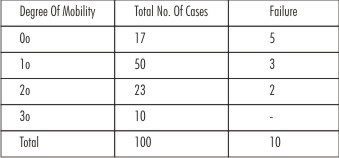 | Table 1 : Degree Of Mobility Of Teeth Extracted Under Acupuncture Analgesia
 |
Table 2 shows the time of onset of analgesia in acupuncture anesthesia. Under acupuncture analgesia time of onset in patients with mechanical stimulation was 97 sec. as compared to 90 sec. in electrical stimulation.
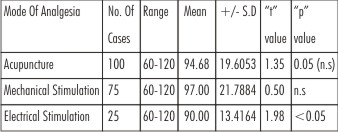 | Table 2 : Time Of Onset Of Analgesia (In Sec.)
 |
In acupuncture the depth of analgesia was 42.10. The depth of analgesia was 40.90 with mechanical stimulation while with electrical stimulation was 44.3 as shown in Table 3.
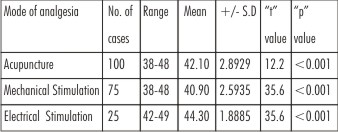 | Table 3 : Depth Of Analgesia
 |
Table 4 depicts that the duration of analgesia in acupuncture was 22min. Under acupuncture analgesia the duration of analgesia in patients stimulated by mechanical stimulation was 21min. as compared to electrical stimulation 24min.
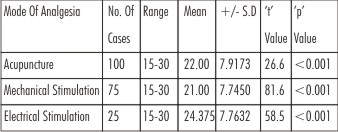 | Table 4 : Duration Of Analgesia (min)
 |
Table 5 shows the effect of acupuncture analgesia on pulse rate. No significant change was seen pre and post-extraction in both the methods of stimulation.
 | Table 5 : Effect On Pulse Rate
 |
Table 6 shows the changes pre and post extraction in systolic blood pressure in the two methods of stimulation under acupuncture analgesia. No significant change was noticed in any group.
 | Table 6 : Effect On Systolic Blood Pressure
 |
Effect of analgesia on diastolic blood pressure under acupuncture is shown in Table 7. No significant change was noticed in any group under mechanical and electrical Stimulation.
 | Table 7 : Effect On Diastolic Blood Pressure
 |
Table 8 shows the change in respiratory rate and it was observed that no significant change was seen pre and post extraction under mechanical and electrical stimulation of acupuncture.
 | Table 8 : Effect On Respiratory Rate
 |
Table 9 shows bleeding during extraction. In mechanical stimulation moderate bleeding was observed in 35 cases while in electrical stimulation it was in 10 cases. There was no case of severe bleeding in both the groups. The table shows that there is no significant difference in amount of bleeding in both the groups.
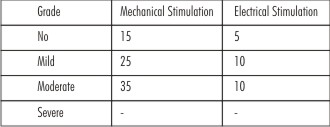 | Table 9 : Bleeding During Extraction
 |
Discussion
It is necessary to achieve good analgesia for successful tooth extraction. A suitable analgesic agent should be ideal, economical, easier in technique and safer for the patient. Acupuncture, an old traditional Chinese method of treatment has been successfully used for inducing analgesia. Varied surgical procedures such as oral-maxillofacial operation (Qiu Weiliw, 1977) have been successfully done under this mode of therapy. To explore the mechanism of acupuncture analgesia various experimental and clinical studies have been done and several theories have been put forward to explain the pain relieving effects of acupuncture, the important one includes “Gate control theory of Pain” proposed by R.Melzack and P.D.Wall (1965)and “encephaline-endorphine theory proposed by Dr. Bruce Pomeranz and his co-workers. Because of paucity of organized clinical trials in Indian masses, it was decided to evaluate the efficacy of acupuncture analgesia in dental extractions.
Under acupuncture analgesia over all success in my study was obtained in 90% of cases. This indicates that the success by this method used was satisfactory. The mean time of onset of acupuncture analgesia was 94.66 secs. It is obvious from these findings that onset of acupuncture analgesia is quite quick. The onset of analgesia was far less (90 secs.) in those cases where electrical stimulation was employed as compared to those done under mechanical stimulation (97secs). It is also found that the time of stimulation is more for the posterior teeth as compared to the anterior ones. In a study by Scarsella et al. of electro-acupuncture treatment for post treatment pain in oral surgery was due to increase in beta-endorphin [7].
The depth of analgesia in acupuncture was significantly less (p<0.001) 42.10%.In the cases with electrical stimulation the depth was 44.30% as compared to 40.90%with mechanical stimulation. These findings can be explained by the fact that only low frequency currents for a very small duration were used in the present cases. The depth of analgesia also can be increased by increasing the frequency and duration of the current used.
The duration of analgesia in acupuncture (22.06 mins.) was significantly less ( p < 0.001). However the duration of analgesia actually depends on the duration of stimulation of the needles. Moreover, the duration of analgesia is longer with the higher frequency electrical current stimulation. It is a significant finding that even low frequency electrical stimulation for 90 secs can produce sufficient analgesia for a painless tooth extraction.
Regarding the degree of mobility, acupuncture analgesia was more successful in 10 and 20 mobile teeth. Out of 17 firm teeth extracted, there was failure in 5 extractions while in mobile teeth there was much success[8],[9],[10]. There were no significant changes on the vitals - pulse rate, systolic, diastolic blood pressure, and respiratory rate in acupuncture analgesia. One is left to ponder why there is not excessive bleeding in extraction in acupuncture analgesia. It seems that acupuncture analgesia produces some sort of local vasoconstrictive effect. Similar view is held by Nagayama (1977). This indicates that acupuncture is a safe test analgesic method. But in the study of acupuncture in operative dentistry by Taub et al. does not find in favor of acupuncture .The drawback of the study was the only inclusion criteria were the need for drilling teeth and that patients had previously required analgesic for a similar treatment[11]. The paper on acupuncture anesthesia in dentistry by Lee et al. was in favor of acupuncture[12]. In the paper by Lao et al. on acupuncture analgesia for post operative dental pain the weakness was the selection of cases for the removal of third molar, which can be a painful procedure[13]. Ekblom et al. found increased postoperative pain and consumption of analgesics following acupuncture for dental extraction. The reason for this could be that wrong acupuncture points had been used[14],[15].
It is clear from this study that onset, duration and depth of analgesia of acupuncture were good in tooth extraction. Quick onset of analgesia, satisfactory duration and suitable depth were obtained in cases of acupuncture analgesia which are the ideal requirements of an analgesic drug, Acupuncture showed no sensitivity reaction and no sensitivity test was required before the insertion of needles.[16],[17] No overdoses and allergy were reported in this technique of analgesia. It is hoped with passage of time, more popularity of system for treatment among the masses and it may be possible to benefit greater fraction of the population.
Conclusion
In view of growing experimental and clinical support this study concluded.
1. The painless tooth extraction is possible under acupuncture analgesia in 90% of cases.
2. The time of onset of acupuncture analgesia is less in anterior teeth as compared to posterior teeth.
3. The duration of analgesia of acupuncture depends on the duration stimulation of needles.
4. Acupuncture may be used in lignocaine hydrochloride sensitive cases.
5. Acupuncture can be successfully used in cases where epinephrine is contraindicated.
References
1. Bannerman R,H. “Acupuncture; the W.H.O. view”. World Health, 1979 24th Dec., 24-29.
2. Bishe, Xu-Jinxing; Gao Jiyuan, Lishanmin “Studies of the anti inflammatory effects of acupuncture”. National Symposia of Acupuncture on Moxi bustion and Acupuncture Anaesthesia, Peking, 1979 June 1-5.
3. Brandwein, A. “Acupuncture analgesia in Dentistry”. Am. J.Acupuncture. 1976, 4(4); 370-5,
4. Bonica, John,J. Acupuncture anaesthesia in the peoples’Republic of China. J.A.M.A. 1974, 229;1317-1325,Sept.2,
5. Brandwein,A. “Acupuncture analgesia in Dentistry”.Am.J.Acupuncture. 1976, 4(40):370-5,
6. Daskalakis,D. “Application of Acupuncture in Dentistry”.Odontiatriki, 1977, 10(1):45-9,
7. Scarsella S,Palattella A,Mariani P,Palattella G”Electroacupuncture treatment of post-operative pain in oral surgery” , Acupuncture in Medicine, 1994, 12(2):75-7
8. Desai,M.M. “Acupuncture,a study of its theories, techniques and practice”.J.Assn. Physician India, 1974, 22(2):129-36,
9. Ecuyer,J.;Lepoivre,L.L.;Lande,M. “Analgesia by Acupuncture”. 1976, 58(39) :41-5.
10. Gu Zugian “The clinical analysis of 582 cases of tooth extraction under Acupuncture anesthesia”.Advances in acupuncture and acupuncture anesthesia, 1980
11. Taub HA,Mitchell JN,Stuber EF,Eisenberg L,Beard MC,McCormack RK “Analgesia for operative dentistry:a comparision of acupuncture and placebo,Oral Surgery,Oral Medicine, Oral Pathology. 1979, 48(3):205-10
12. Lee MHM,Teng P,Zaretsky HH,Rubin M Acupuncture anaesthesia in dentistry, New York State Dental Journal. 1973, 39(5):299-301
13. Lao L, Bergman S,Langenberg P, Wong RH, Berman B. ”Efficacy of Chinese acupuncture on post-operative oral surgery pain. Oral Surgery,Oral Medicine, Oral Pathology, 1995, 79(4):423-8
14. Ekblom A,Hansson I,Thomsson M,Thomas M. Increased post-operative pain and consumption of analgesics following acupuncture. Pain, 1991, 44(3):241-7
15. Jayasuriya,A.and Fernando,Felix. “Principle and Practice of Scientific Acupuncture”Ist edition Colombo Lake House Investment Ltd., Book Publisher. 1978
16. Jayasuriya,A.“Clinical Acupuncture”.Ist edition ,The Acupuncture Foundation of Srilanka,Colombo. 1979
17. Liu Jianhua. “The application of acupuncture anesthesia in maxillofacial surgery”.Advances in acupuncture anaesthesia. 1970-75.
|